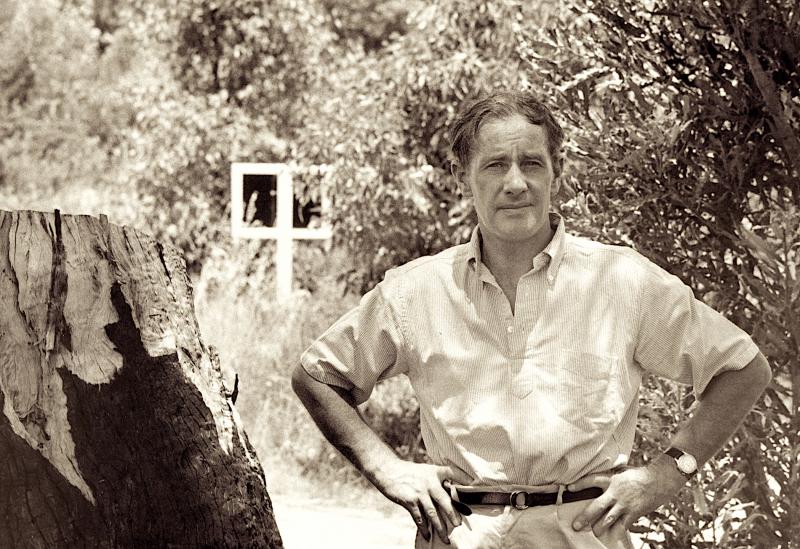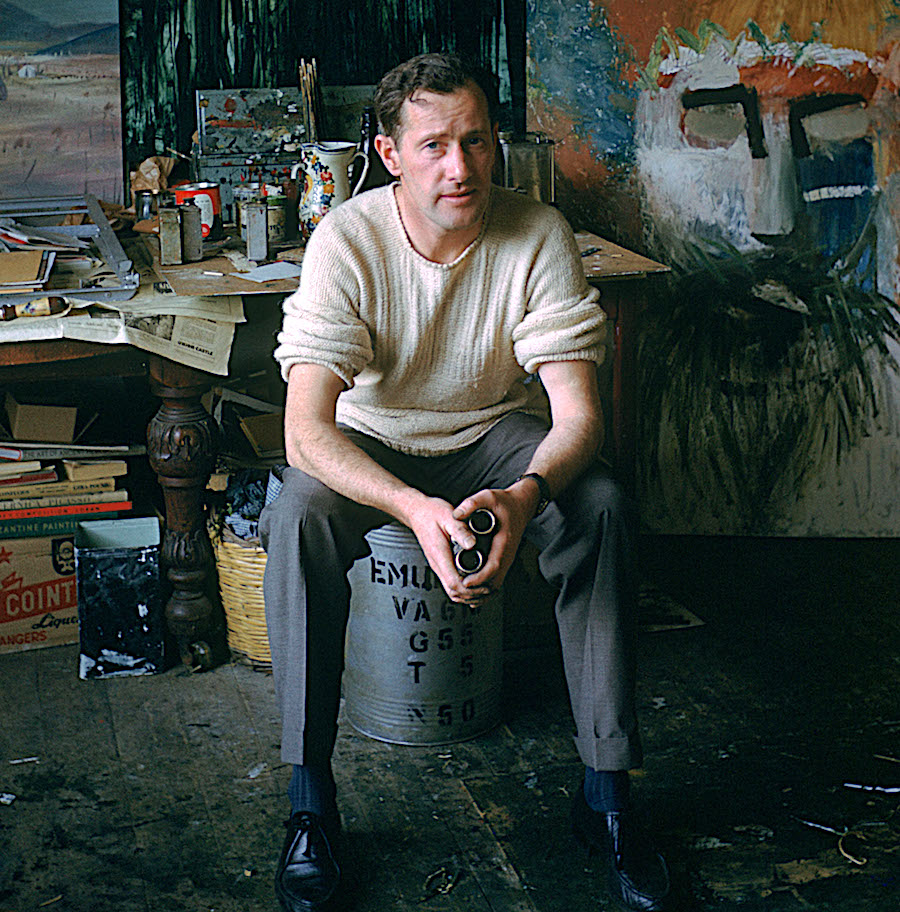Nolan: Australia's Maverick Artist, BBC Four review – a lust for life in all its aspects | reviews, news & interviews
Nolan: Australia's Maverick Artist, BBC Four review – a lust for life in all its aspects
Nolan: Australia's Maverick Artist, BBC Four review – a lust for life in all its aspects
The gifted painter from Down Under who rocked the art world

Reckless, unstoppable, one step ahead of everyone else, a hell of a lot of fun, utterly charming, street smart – descriptions of the artist Sidney Nolan (1917-1992) poured out from colleagues, rivals, curators, art historians and dealers, not to mention friends and family, in this persuasive film.
All agreed you could not compare this working-class original with anybody else. But first we heard Nolan himself eulogising gum trees, the river and the Australian sunlight, and from time to time the programme opened up to the landscapes of Oz which so moved the artist, from lush greenery to the surreal moonscapes of drought punctuated by the desiccated carcasses of sun-baked animal, victims of the extreme climate. At 14 Nolan left school and his enormous energy was turned to the arts. He was, we were told, an Artist with a capital A and painting took over his life. He eloped with Elizabeth, a young art student, and had a daughter, Alameda. All his life he insisted on his working-class roots, and had an intense love-hate relationship with the Establishment from Oz. He was based in England for his last 40 years.
At 14 Nolan left school and his enormous energy was turned to the arts. He was, we were told, an Artist with a capital A and painting took over his life. He eloped with Elizabeth, a young art student, and had a daughter, Alameda. All his life he insisted on his working-class roots, and had an intense love-hate relationship with the Establishment from Oz. He was based in England for his last 40 years.
A big exhibition of modern art was brought to Melbourne in the 1930s by Keith Murdoch (the father of you-know-who) and his Herald newspaper, and at 21, Nolan was swept away; with no money to back him up, he metaphorically jumped off the cliff. Early Nolan created energetic derivative abstracts, resonant with colour, and caused a scandal: a viable plausible push for modernism in Australia, zero acceptance in Melbourne. John and Sunday Reed, defying prevailing opinion, became patrons andd offered financial support. Nolan joined the Reeds. Sidney fell for Sunday who was his aide de camp for the Ned Kelly paintings which he painted at the Reeds’ dining room table and were to make his name (Nolan does Ned Kelly, pictured above).
The imaginative scenes set in the iconic Australian landscape of the outlaw remain a huge achievement, with one fetching the highest price yet for a 20th century Australian painting – over $5m. Complications ensued with a menage à trois; then Sunday would not leave John to be with Sidney and Sidney left his own tiny family, reconnecting with his daughter years later when he and a television crew visited. You couldn’t make it up. The tiny avant-garde artistic community included Arthur Boyd, Albert Tucker and John Perceval.
Nolan’s passion for landscape was portrayed with compelling vistas of Australia’s extraordinary and idiosyncratic nature. We witnessed the pink sheen of central Australia and the aerial views that so affected Nolan, and the surreal moonscape aridity of drought-affected Queensland. The next twist and turn was the unexpected patronage of Kenneth Clark, the Lord of Civilisation himself who persuaded the young artist to come to London. Nolan married his second wife, Cynthia, John Reed’s sister. A depressive, she later committed suicide. Nolan’s third wife was Mary, Arthur Boyd’s sister. Living in London, Nolan became the first Australian artist to have a reputation outside his homeland.
 He worked and networked incessantly, vintage film showing him with the great and the good, royals and all, at grand gallery openings, the decorum already charmingly dated. And he travelled incessantly – Antarctica, the Silk Road, China, Africa, all scenes for his omnivorous practice, putting human narrative into a global landscape. Nolan had a sharply focussed visual memory, referring often to his quick flicks as he explored the imagery stored in his brain. He loved new possibilities, was addicted to taking Polaroids and finally to the possibilities of the Paintbox computer programme.
He worked and networked incessantly, vintage film showing him with the great and the good, royals and all, at grand gallery openings, the decorum already charmingly dated. And he travelled incessantly – Antarctica, the Silk Road, China, Africa, all scenes for his omnivorous practice, putting human narrative into a global landscape. Nolan had a sharply focussed visual memory, referring often to his quick flicks as he explored the imagery stored in his brain. He loved new possibilities, was addicted to taking Polaroids and finally to the possibilities of the Paintbox computer programme.
He used house paint, industrial paint, spray paint, his hands and fingers as well as brushes, ever innovative. Complacency he considered the enemy: artists, he declared, were people who could think rather than people who could paint. Throughout, he had also designed for stage and theatre. London’s Royal Opera thought him a genius, and his set and costume designs for Saint-Saens’ Samson and Delilah (1981) were an innovative landmark.
This documentary was a surprisingly unpretentious and convincing portrait of an artist, persuasively showing in what particular ways Nolan evolved his own idiosyncratic and memorable language. He was motivated by his relentless curiosity and relentless imagination, no maverick he but a true original. However inexplicable the nature of inspiration, it was an informative pleasure to observe Sidney Nolan through the landscapes he saw, the observations of professionals and family, and a complex web of personal relationships. And there was the curiously elegant figure of the man himself as he wove his illuminating way through the various worlds he inhabited.
Add comment
The future of Arts Journalism
You can stop theartsdesk.com closing!
We urgently need financing to survive. Our fundraising drive has thus far raised £49,000 but we need to reach £100,000 or we will be forced to close. Please contribute here: https://gofund.me/c3f6033d
And if you can forward this information to anyone who might assist, we’d be grateful.

Subscribe to theartsdesk.com
Thank you for continuing to read our work on theartsdesk.com. For unlimited access to every article in its entirety, including our archive of more than 15,000 pieces, we're asking for £5 per month or £40 per year. We feel it's a very good deal, and hope you do too.
To take a subscription now simply click here.
And if you're looking for that extra gift for a friend or family member, why not treat them to a theartsdesk.com gift subscription?
more TV
 Slow Horses, Series 5, Apple TV+ review - terror, trauma and impeccable comic timing
Jackson Lamb's band of MI5 misfits continues to fascinate and amuse
Slow Horses, Series 5, Apple TV+ review - terror, trauma and impeccable comic timing
Jackson Lamb's band of MI5 misfits continues to fascinate and amuse
 Coldwater, ITV1 review - horror and black comedy in the Highlands
Superb cast lights up David Ireland's cunning thriller
Coldwater, ITV1 review - horror and black comedy in the Highlands
Superb cast lights up David Ireland's cunning thriller
 Blu-ray: The Sweeney - Series One
Influential and entertaining 1970s police drama, handsomely restored
Blu-ray: The Sweeney - Series One
Influential and entertaining 1970s police drama, handsomely restored
 I Fought the Law, ITVX review - how an 800-year-old law was challenged and changed
Sheridan Smith's raw performance dominates ITV's new docudrama about injustice
I Fought the Law, ITVX review - how an 800-year-old law was challenged and changed
Sheridan Smith's raw performance dominates ITV's new docudrama about injustice
 The Paper, Sky Max review - a spinoff of the US Office worth waiting 20 years for
Perfectly judged recycling of the original's key elements, with a star turn at its heart
The Paper, Sky Max review - a spinoff of the US Office worth waiting 20 years for
Perfectly judged recycling of the original's key elements, with a star turn at its heart
 The Guest, BBC One review - be careful what you wish for
A terrific Eve Myles stars in addictive Welsh mystery
The Guest, BBC One review - be careful what you wish for
A terrific Eve Myles stars in addictive Welsh mystery
 theartsdesk Q&A: Suranne Jones on 'Hostage', power pants and politics
The star and producer talks about taking on the role of Prime Minister, wearing high heels and living in the public eye
theartsdesk Q&A: Suranne Jones on 'Hostage', power pants and politics
The star and producer talks about taking on the role of Prime Minister, wearing high heels and living in the public eye
 King & Conqueror, BBC One review - not many kicks in 1066
Turgid medieval drama leaves viewers in the dark
King & Conqueror, BBC One review - not many kicks in 1066
Turgid medieval drama leaves viewers in the dark
 Hostage, Netflix review - entente not-too-cordiale
Suranne Jones and Julie Delpy cross swords in confused political drama
Hostage, Netflix review - entente not-too-cordiale
Suranne Jones and Julie Delpy cross swords in confused political drama
 In Flight, Channel 4 review - drugs, thugs and Bulgarian gangsters
Katherine Kelly's flight attendant is battling a sea of troubles
In Flight, Channel 4 review - drugs, thugs and Bulgarian gangsters
Katherine Kelly's flight attendant is battling a sea of troubles
 Alien: Earth, Disney+ review - was this interstellar journey really necessary?
Noah Hawley's lavish sci-fi series brings Ridley Scott's monster back home
Alien: Earth, Disney+ review - was this interstellar journey really necessary?
Noah Hawley's lavish sci-fi series brings Ridley Scott's monster back home
 The Count of Monte Cristo, U&Drama review - silly telly for the silly season
Umpteenth incarnation of the Alexandre Dumas novel is no better than it should be
The Count of Monte Cristo, U&Drama review - silly telly for the silly season
Umpteenth incarnation of the Alexandre Dumas novel is no better than it should be

Comments
Are you sure Cynthia was
Are you sure Cynthia was Sunday sister ( or SIL ) ?
From: theartsdesk
Many thanks to those who pointed out that Cynthia was John Reed's sister, not Sunday's. Now corrected.